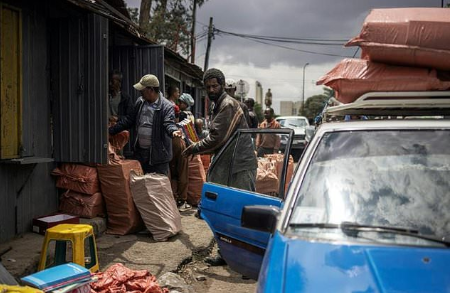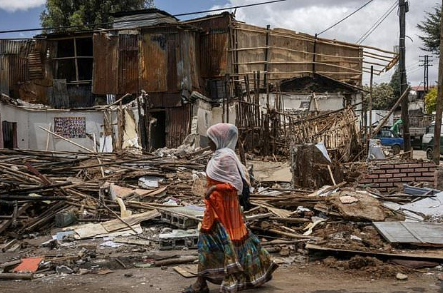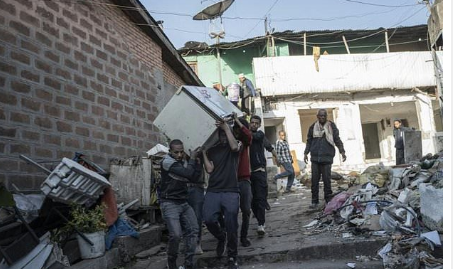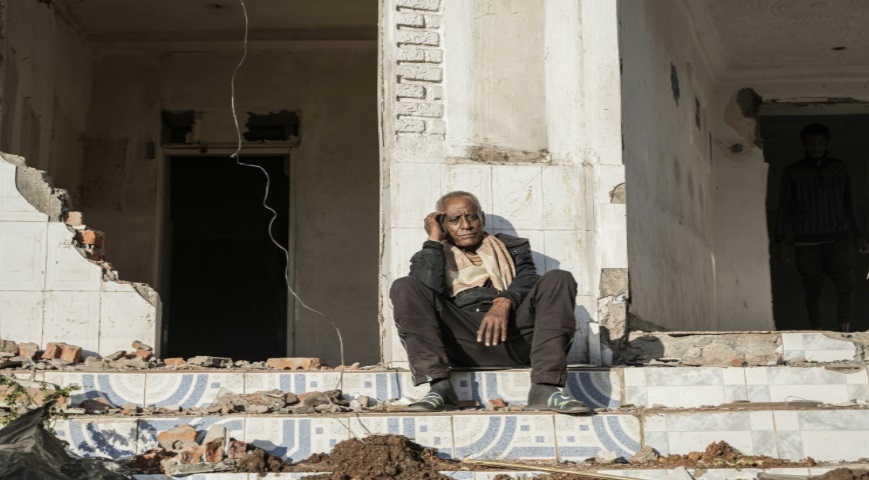Ethiopians are unhappy since the historic Piassa district is no more. The demolition in Piassa is part of an urban renewal scheme for Addis Ababa
"Our history and our identity have been erased," laments Samira after the destruction of her birthplace in the historic Piassa district in the heart of Ethiopia's capital.
In recent weeks, bulldozers have demolished numerous buildings in Piassa, some of which have stood for a century, as part of a modernization initiative by the authorities.
Large sections of the lively yet somewhat dilapidated neighborhood now lie in dusty heaps of rubble, with locals often receiving minimal notice to vacate their homes or businesses.
Several historically significant and beloved sites in the area, including Ethiopia's first baklava bakery, jewelry and gold shops, and bustling cafes, have been eradicated.

Critics argue that the urban renewal initiative, known as the Addis Ababa Corridor Development Project, has not only demolished buildings but also disrupted the social fabric of Piassa. In this vibrant neighborhood, individuals from diverse backgrounds once mingled in its cobbled streets.
"A lot of cherished history has been destroyed," says Samira, a 30-year-old government employee who like other residents interviewed by AFP did not want to give her name for fear of reprisals.
The local authorities had informed the family that the home where Samira was born and raised would be razed "without telling us the exact date".
"They cut our water and electricity the following weekend, then we were given a day and a half notice to leave," says the mother of a baby daughter, mourning the family memories lost or damaged in the hasty move.
Fellow Piassa resident Sami tells a similar story.
"Everything went at the speed of light," he says, recounting how the building owned by his father that housed Sami's printing shop business and other stores was torn down.
The Reporter newspaper, citing official data, said 56 listed buildings in Piassa have already been totally or partly demolished
"I used to have a shop, but now I don't," the 40-year-old says grimly.
"Yes, it's old, but that doesn't mean it's trash... It's our heritage."
- 'Unique' urban environment -
The Arada district, originally named "Piazza" by Mussolini's occupying forces in the 1930s and commonly referred to as Piassa to this day, was established around a large market in the early 20th century.
"Arada was the commercial heart of the Ethiopia of Menelik II," says anthropologist Dominique Harre, referring to the emperor who ruled from 1889 to 1913.
Harre, author of the "Addis Ababa Old Piazza" guidebook, says large trading houses -- Indian, Armenian, Greek, French, Ethiopian -- set up around the market and in the nearby streets.
This cosmopolitan society created a "unique urban" environment with an eclectic mix of architectural influences, she says.
Since the 1920s, warehouses operated by the traders have stood alongside small kiosks and stores, while elegant stone and wood villas owned by wealthy merchants or dignitaries co-existed with more modest homes.

"What is really unique in Piassa is that it was built... with African characteristics, contrary to other African capitals" that were built by colonial powers with "colonial urban planning," says architect Piet Nieder.
Nieder, author of "The Addis Ababa House" about Ethiopia's urban heritage from its founding in 1886 to 1936, says the city has lived through such demolitions and evictions in the past as the sprawling metropolis developed.
"But what is new is the extent of the current destructions. So many households are being destroyed simultaneously."
- 'Our heritage' -
Since coming to power in 2018, Prime Minister Abiy Ahmed has embarked on a number of grandiose projects including a new multi-billion-dollar presidential palace in Addis Ababa, and a new museum right on the edge of Piassa.

The significant expenditure has drawn attention in a country where, according to the UN, over 21 million people require assistance due to conflict and climate-related disasters.
According to The Reporter newspaper, citing official data, 56 listed buildings in Piassa have already been completely or partially demolished.
Abebaw Ayalew, director of the Ethiopian Heritage Authority, asserts that the organization has been closely monitoring the development work to safeguard the nation's cultural heritage.
But he told reporters: "The age of a building alone does not automatically render it eligible for heritage status".
Addis mayor Adanech Abebe has defended the project, saying it will benefit all of society with the creation of wide roads, bike paths and children's playgrounds.
"Some areas were falling apart even before we started demolishing them," she said. "We have preserved memories that should be preserved."
Most of the cleared sites in Piassa will be put up for auction, according to the municipal authorities.
Those evicted have complained about the lack of financial compensation and the relocation sites.
Azeb, a Piassa trader for 30 years, says she was offered land "far from the road and unsuitable for any construction either a house or a commercial property".
The block where Samira has been allocated an apartment is "a skeleton of a building, with no windows or doors, no plumbing, no water or electricity... no toilet", she says.
"It's not even fit to house animals."
Samira says the mixed population of Piassa has been scattered.
"The next time our children ask questions about our heritage and where we grew up, there will be nothing to show them."









